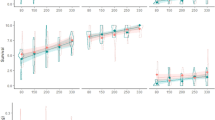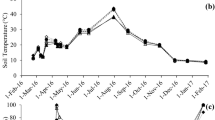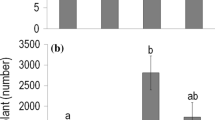Abstract
Invasive species are detrimental to ecosystems worldwide, and long-term invasive treatment outcomes are generally poor. Integrating active restoration into an invasive species treatment plan by seeding with species that that can competitively suppress the invader may help to improve treatment outcomes. Buffelgrass is a drought tolerant perennial grass that is highly invasive and disruptive to dryland ecosystem biodiversity across the globe. In this greenhouse experiment, we examine how buffelgrass growth and traits were impacted by the combination of competition with eight native grasses species and water availability. We found that when buffelgrass was grown with species that establish rapidly and have large biomass, buffelgrass tends to exhibit rapid growth, despite becoming more drought stressed. Conversely, when buffelgrass was grown with species that are slow growing and conserve their size under drought conditions, buffelgrass biomass is arrested. The ability to adjust its strategy depending on its neighbor’s strategy and on the amount of precipitation makes buffelgrass a robust invader. However, our results showed that growing buffelgrass with drought tolerant perennial grass neighbors reduced buffelgrass shoot biomass by up to 95% when grown in drought conditions. This indicates that seeding with native grasses after buffelgrass treatment is a beneficial option for suppressing re-invasion from the seedbank.


Similar content being viewed by others
References
Balachowski JA, Volaire FA (2018) Implications of plant functional traits and drought survival strategies for ecological restoration. J Appl Ecol 55(2):631–640
Balazs KR, Kramer AT, Munson SM, Talkington N, Still S, Butterfield BJ (2020) The right trait in the right place at the right time: Matching traits to environment improves restoration outcomes. Ecol Appl 30(4):e02110
Blumenthal DM, Mueller KE, Kray JA, Ocheltree TW, Augustine DJ, & Wilcox KR, Traits link drought resistance with herbivore defense and plant economics in semiarid grasslands: the central roles of phenology and leaf dry matter content. J Ecol
Brown CS, Anderson VJ, Claassen VP, Stannard ME, Wilson LM, Atkinson SY, Bromberg JE, Grant TA, Munis MD (2008) Restoration ecology and invasive plants in the semiarid west. Invasive plant sci manag 1(4):399–413
Byun C, de Blois S, Brisson J (2013) Plant functional group identity and diversity determine biotic resistance to invasion by an exotic grass. J Ecol 101(1):128–139
Byun C, de Blois S, Brisson J (2018) Management of invasive plants through ecological resistance. Biol Invasions 20(1):13–27
Castellanos AE, Celaya-Michel H, Rodríguez JC, Wilcox BP (2016) Ecohydrological changes in semiarid ecosystems transformed from shrubland to buffelgrass savanna. Ecohydrology 9(8):1663–1674
Chen D, Wang S, Xiong B, Cao B, Deng X (2015) Carbon/nitrogen imbalance associated with drought-induced leaf senescence in Sorghum bicolor. PloS one 10(8):e137026
Corbin JD, D’Antonio CM (2012) Gone but not forgotten? invasive plants’ legacies on community and ecosystem properties. Invasive Plant Sci Manag 5(1):117–124
Craine JM (2009) Resource strategies of wild plants. Princeton University Press
De Battisti D, Fowler MS, Jenkins SR, Skov MW, Bouma TJ, Neyland PJ, Griffin JN (2020) Multiple trait dimensions mediate stress gradient effects on plant biomass allocation, with implications for coastal ecosystem services. J Ecol 108(4):1227–1240
Dixon IR, Dixon KW, Barrett M (2002) Eradication of buffel grass (Cenchrus ciliaris) on Airlie Island, Pilbara Coast, Western Australia. In: Turning the Tide: Eradication of Invasive Species. Gland, Switzerland, International Union, pp. 92–101
Eilts JA, Huxman TE (2013) Invasion by an exotic, perennial grass alters responses of a native woody species in an arid system. J Arid Environ 88:206–212
Espinoza DO, Molina-Freaner F, Tinoco-Ojanguren C (2020) Response of four species of Sonoran Desert trees to buffel grass removal treatments. Plant Ecol 221:255–264
Farrell HL, Gornish ES (2019) Pennisetum ciliare: a review of treatment efficacy, competitive traits, and restoration opportunities. Invasive Plant Sci Manag 12(4):203–213
Field C, Merino J, Mooney H (1983) Compromises between water-use efficiency and nitrogen-use efficiency in five species of California evergreens. Oecologia 60(3):384–389
Fowler N (1986) The role of competition in plant communities in arid and semiarid regions. Annu Rev Ecol Syst 17(1):89–110
Funk JL, Vitousek PM (2007) Resource-use efficiency and plant invasion in low-resource systems. Nature 446(7139):1079–1081
Funk JL, Wolf AA (2016) Testing the trait-based community framework: do functional traits predict competitive outcomes? Ecology 97(9):2206–2211
Funk JL, Cleland EE, Suding KN, Zavaleta ES (2008) Restoration through reassembly: plant traits and invasion resistance. Trends Ecol Evol 23(12):695–703
Funk JL, Standish RJ, Stock WD, Valladares F (2016) Plant functional traits of dominant native and invasive species in mediterranean-climate ecosystems. Ecology 97(1):75–83
Gornish ES, Tylianakis JM (2013) Community shifts under climate change: mechanisms at multiple scales. Am J Bot 100(7):1422–1434
Gremer JR, Kimball S, Keck KR, Huxman TE, Angert AL, Venable DL (2013) Water-use efficiency and relative growth rate mediate competitive interactions in Sonoran Desert winter annual plants. Am J Bot 100(10):2009–2015
Gornish ES, Case E, Valle M, Bean TM, Moore-O’Leary KA (2018) A systematic review of management efforts on goatgrass (Aegilops spp) dominance. Plant Ecol 219(5):549–560
Gutterman Y (2012) Seed germination in desert plants. Springer, Berlin, pp 1–24
Harker KN, Blackshaw RE (2003) Leaf expansion rate may help determine when low wild oat herbicide rates will be effective. Weed Technol 17:829–835
He M, Dijkstra FA (2014) Drought effect on plant nitrogen and phosphorus: a meta-analysis. New Phytol 204(4):924–931
International Seed Testing Association. (1985). International rules for seed testing. Rules 1985. Seed Science and Technology, 13(2), 299–513
Kettenring KM, Adams CR (2011) Lessons learned from invasive plant control experiments: a systematic review and meta-analysis. J Appl Ecol 48(4):970–979
Kimball S, Gremer JR, Barron-Gafford GA, Angert AL, Huxman TE, Venable DL (2014) High water-use efficiency and growth contribute to success of non-native Erodium cicutarium in a Sonoran Desert winter annual community. Conserv Physiol. https://doi.org/10.1093/conphys/cou006
Kooyers NJ (2015) The evolution of drought escape and avoidance in natural herbaceous populations. Plant Sci 234:155–162
LaForgia ML, Harrison SP, Latimer AM (2019) Invasive species interact with climatic variability to reduce success of natives. Ecology 101(6):e03022
Laughlin DC (2014) The intrinsic dimensionality of plant traits and its relevance to community assembly. J Ecol 102(1):186–193
Leishman MR, Haslehurst T, Ares A, Baruch Z (2007) Leaf trait relationships of native and invasive plants: community-and global-scale comparisons. New Phytol 176(3):635–643
Liang J, Zhang J, Wong MH (1997) Can stomatal closure caused by xylem ABA explain the inhibition of leaf photosynthesis under soil drying? Photosynth Res 51(2):149–159
Marra G, Wood SN (2011) Practical variable selection for generalized additive models. Comput Stat Data Anal 55:2372–2387
Marshall VM, Lewis MM, Ostendorf B (2012) Buffel grass (Cenchrus ciliaris) as an invader and threat to biodiversity in arid environments: a review. J Arid Environ 78:1–12
Matzek V (2012) Trait values, not trait plasticity, best explain invasive species’ performance in a changing environment. PloS one 7(10):e48821
Mnif L, Chaieb M (2010) Net photosynthesis and leaf water potential of buffel grass (Cenchrus ciliaris L.) accessions, growing in the arid zone of Tunisia. J Biol Res 14:231
Noble WS (2009) How does multiple testing correction work? Nat Biotechnol 27(12):1135–1137
Ogle K, Reynolds JF (2004) Plant responses to precipitation in desert ecosystems: integrating functional types, pulses, thresholds, and delays. Oecologia 141(2):282–294
Pearson DE, Ortega YK, Runyon JB, Butler JL (2016) Secondary invasion: the bane of weed management. Biol Cons 197:8–17
Polley HW, Briske DD, Morgan JA, Wolter K, Bailey DW, Brown JR (2013) Climate change and North American rangelands: trends, projections, and implications. Rangel Ecol Manage 66(5):493–511
Potts DL, Barron-Gafford GA, Butterfield BJ, Fay PA, Hultine KR (2019) Bloom and Bust: ecological consequences of precipitation variability in aridlands. Plant Ecol 220(2):135–139
Powell KI, Chase JM, Knight TM (2013) Invasive plants have scale-dependent effects on diversity by altering species-area relationships. Science 339(6117):316–318
R Core Team (2020). R: A language and environment for statistical computing. R Foundation for Statistical Computing, Vienna, Austria. URL https://www.R-project.org/
Rajaniemi TK (2007) Root foraging traits and competitive ability in heterogeneous soils. Oecologia 153(1):145–152
Schwinning S, Sala OE (2004) Hierarchy of responses to resource pulses in arid and semi-arid ecosystems. Oecologia 141(2):211–220
Soliveres S, Maestre FT, Bowker MA, Torices R, Quero JL, García-Gómez M, Espinosa CI (2014) Functional traits determine plant co-occurrence more than environment or evolutionary relatedness in global drylands. Perspect Plant Ecol Evol Systmat 16(4):164–173
Stevens JM, Fehmi JS (2011) Early establishment of a native grass reduces the competitive effect of a non-native grass. Restor Ecol 19(3):399–406
Suding KN, Goldberg DE (2001) Do disturbances alter competitive hierarchies? Mechanisms of change following gap creation Ecology 82:2133–2149
USDA, NRCS. (2020) The PLANTS Database (http://plants.usda.gov, 21 February 2021). National Plant Data Team, Greensboro, NC 27401–4901 USA
Valliere JM (2019) Tradeoffs between growth rate and water-use efficiency in seedlings of native perennials but not invasive annuals. Plant Ecol 220(3):361–369
Van Kleunen M, Weber E, Fischer M (2010) A meta-analysis of trait differences between invasive and non-invasive plant species. Ecol Lett 13(2):235–245
Wainwright CE, Wolkovich EM, Cleland EE (2012) Seasonal priority effects: implications for invasion and restoration in a semi‐arid system. J Appl Ecol 49(1):234–241
Ward JP, Smith SE, McClaran MP (2006) Water requirements for emergence of buffelgrass (Pennisetum ciliare). Weed Sci 54(4):720–725
Wilcox BP, Turnbull L, Young MH, Williams CJ, Ravi S, Seyfried MS, Wainwright J (2012) Invasion of shrublands by exotic grasses: ecohydrological consequences in cold versus warm deserts. Ecohydrology 5(2):160–173
Wood SN (2001) mgcv: GAMs and generalized ridge regression for R. R News 1(2):20–25
Woods SR, Fehmi JS, Backer DM (2012) An assessment of revegetation treatments following removal of invasive Pennisetum ciliare (buffelgrass). J Arid Environ 87:168–175
Acknowledgements
Thank you to Albert Kline, Angel Vega, and Tristan Stevens for their assistance in the greenhouse. Thank you to the Funk lab for their assistance processing the leaf samples.
Author information
Authors and Affiliations
Contributions
HLF & ESG conceived of the research idea; HLF and DL collected data; HLF performed statistical analyses; HLF wrote the paper; all authors discussed the results and commented on the manuscript.
Corresponding author
Additional information
Publisher's Note
Springer Nature remains neutral with regard to jurisdictional claims in published maps and institutional affiliations.
Appendix
Appendix
See Fig. 3 .
Rights and permissions
About this article
Cite this article
Farrell, H.L., Funk, J., Law, D. et al. Impacts of drought and native grass competition on buffelgrass (Pennisetum ciliare). Biol Invasions 24, 697–708 (2022). https://doi.org/10.1007/s10530-021-02671-9
Received:
Accepted:
Published:
Issue Date:
DOI: https://doi.org/10.1007/s10530-021-02671-9





